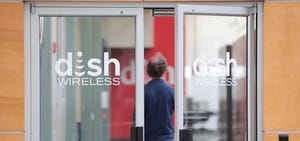AT&T's fixed wireless play gets 'bigger and louder'
AT&T is still being selective on the availability of 'Internet Air,' but it's broadening the reach of the new fixed wireless product, including into several markets where AT&T has no wireline presence at all.

AT&T is done flirting with fixed wireless access (FWA). It's not about to get married to the technology, but the company is getting more serious about it.
Four months after soft-launching its new FWA service in select markets, AT&T is expanding the reach of its Internet Air service to several additional US markets while also broadening the types of customers it's targeting with the product.
The next wave of Internet Air markets (see list below) offers a mix of areas where AT&T will continue to use the 5G-based product to capture customers on aging copper infrastructure, markets where the company also offers fiber-to-the-premises (FTTP) service in some areas, and in several cities and towns where AT&T has no existing wireline offerings. Some of AT&T's new FWA markets, such as Las Vegas, are also being targeted by Gigapower, the AT&T-BlackRock joint venture that is building fiber networks to an initial 1.5 million locations outside AT&T's legacy wireline footprint.
The market expansion signals that the company is "getting bigger and louder on our AT&T Internet Air product," Erin Scarborough, president of broadband and connectivity initiatives at AT&T, said during a recent briefing that shed more light on the new offering and AT&T's broader FWA strategy.
AT&T's cap-free, no-contract Internet Air product starts at $55 per month, a price that includes the customer premises equipment (CPE). Customers who bundle in AT&T's mobile service can get Internet Air at the discounted price of $35 per month. Eligible households can also get discounts on Internet Air from the FCC's Affordable Connectivity Program (ACP). For homes that require mesh coverage, AT&T is also leasing Wi-Fi extenders for an additional $10 per month (up to five per household, based on AT&T's determination).
Internet Air is primarily being deployed under a self-install model via a box that contains the gateway, a power cord and QR codes on and inside the box, providing a link to AT&T's Smart Home Manager app. Internet Air customers using the app are walked through a five-step installation process that also helps customers determine where to obtain maximum visibility to the tower. A green check mark will tell customers that the gateway has access to a solid signal.

AT&T will lean heavily on a self-install model for Internet Air, noting that customers can typically complete the process in less than 15 minutes.
(Source: AT&T)
"We wanted to make [installations] incredibly easy," Angela Wilkin, assistant vice president, product management and development, AT&T, said. "This is a very interactive experience between the gateway, the Smart Home Manager app and the customer moving about their house."
AT&T is backing Internet Air with a dedicated call center. The company is selling Internet Air at retail stores and online.
Below is a list of AT&T's FWA expansion markets:
Table 1: AT&T FWA expansion markets
Los Angeles, Calif. | Philadelphia, Pa. | Cincinnati, Ohio | Harrisburg-Lancaster-Lebanon, Pa. |
Pittsburgh, Pa. | Las Vegas, Nev. | Phoenix (Prescott), Ariz. | Chicago, Ill. |
Detroit, Mich. | Flint-Saginaw-Bay City, Mich. | Hartford-New Haven, Conn. | Minneapolis-St. Paul, Minn. |
Portland, Ore. | Salt Lake City, Utah | Seattle-Tacoma, Wash. | Tampa-St. Petersburg (Sarasota, Fla.) |
(Source: AT&T) |
By way of example, AT&T currently has little or no fiber footprint in cities such as Los Angeles, Philadelphia, Cincinnati, Las Vegas, Salt Lake City and Pittsburgh, but it does have copper and fiber in parts of Chicago and Detroit.
AT&T intends to use the expansions to learn more about how the mix plays in the individual markets and to find out which marketing tactics work well, Wilkin said.
The company expects to expand FWA into more markets later this year, she added but didn't elaborate on specific candidates.
Pivoting to 'acquisition markets'
While AT&T's FWA strategy is not as aggressive as T-Mobile's or Verizon's, the expansion into more markets to additional types of customers is a clear signal that AT&T sees potential for fixed wireless, at least in some cases.
Wilkin noted that AT&T's initial strategy with Internet Air was to migrate copper customers first but that the company is now "ready to pivot into some new acquisition markets."
AT&T will make Internet Air available on a targeted basis. If AT&T offers fiber in a given market, such as Phoenix, Internet Air will be marketed and made available in zip codes where fiber is not yet present. AT&T will also focus on Internet Air in areas where it has determined that ample wireless capacity is available to support the service.
Scarborough said Internet Air fits into a broader strategy to bring connectivity to customers using a set of technologies that includes fiber, wireless and satellite.
Fiber's still the focus
AT&T's FWA expansion comes several months after certain company execs were critical of the technology.
"Long term, we don't believe [FWA] will be good enough," AT&T CFO Pascal Desroches said last fall at an investor's conference, calling it a "good catch product" for subs on slow copper lines. "That's why we think it's really important to place our bets now with fiber," he said.
But AT&T has warmed to FWA in certain circumstances, including areas where it possesses "underutilized capacity."
Scarborough stressed that AT&T's FWA expansion does not diverge from AT&T's fiber-focused strategy, as the company is "being very thoughtful, very targeted" with FWA.
"Nothing has changed," she said. "We absolutely still believe that fiber is best-in-class and will continue to be."
Not counting the Gigapower JV, AT&T's current plan is to build fiber to 30 million residential and business locations by 2025. The company has expressed some interest in going beyond that depending in part on how the $42.45 billion Broadband Equity, Access, and Deployment (BEAD) program shakes out.
Related posts:
— Jeff Baumgartner, Senior Editor, Light Reading
About the Author(s)
You May Also Like












